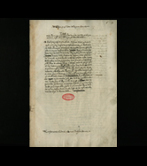The surname: tracing the social history of Gipuzkoa
People are always fascinated by the history of surnames, not surprisingly, because they are closely related to all the people and places in our past. A study of the history of surnames reveals the changes that have taken place in each location, changes in linguistic use and, in general, the relationship of families and their social environment.
What is a surname? The generally accepted definition is that it is a family name by which people identify themselves. However, the Diccionario de Autoridades (1726) defines a surname in a different way. “In the past surnames were the names of the main houses which everyone adopted, and which brought them together; and in this way patronymics became surnames and in due course became family surnames.”
This definition is perfectly applicable to the use of surnames in mediaeval Gipuzcoa, and until the 16th century surnames took the same form as combined surnames have today, and are so resonant that we can immediately identify them as Alaves or Navarrese, and we can immediately associate them with the people from a hamlet (the second part of this type of surname is always the same as the village, many of them today abandoned, such as López de Gereñu, Martínez de Irujo, Díaz de Zerio). In Gipuzkoa, this form of identification changed, with the surname linked only to the house. However, the older form continued among the descendents of important families such as Miguel Lopez de Legazpi or Iñigo López de Loiola, which also denoted different modes of social organization and personal relations.
Therefore, and leaving to one side their use in medieval times, when a surname refers to a group that is larger than the nuclear family (whether it is a lineage such as Gebara or a community, such as Alkiza) from the 14th and 15th centuries onwards, in Gipuzkoa a surname expressed two important social realities. The first of these was the home. In general, in Gipuzkoa everyone adopted a surname, that is to say, a way of distinguishing their family from the rest of society, which was the same as the name of their home. The surname, therefore, was always linked to the place where they lived. This identification between home and individual was so close that when somebody moved, whether through marriage, work or for any other reason they sometimes changed their surname or, at least, combined the two homes that they belonged to, their original and their adopted home. Sometimes people identified themselves with the general region. Thus, a person living in the villa of Tolosa might adopt this as their surname if they moved to another locality. This was particularly the case if they moved far away, especially if they went to America.
This has lead to some surprising results, where a parent, their children and their brothers and sisters might have different surnames. However, from the 17th century surnames started to become fixed and the tendency was to pass on the father’s name, independently of where they lived. When the Civil Register was established in 1870, surnames were regularized with a double and use of the mother’s and father’s name. Since 1986, under a Royal Decree it became possible to choose the order in which these two surnames were recorded.

_petita.jpg)

